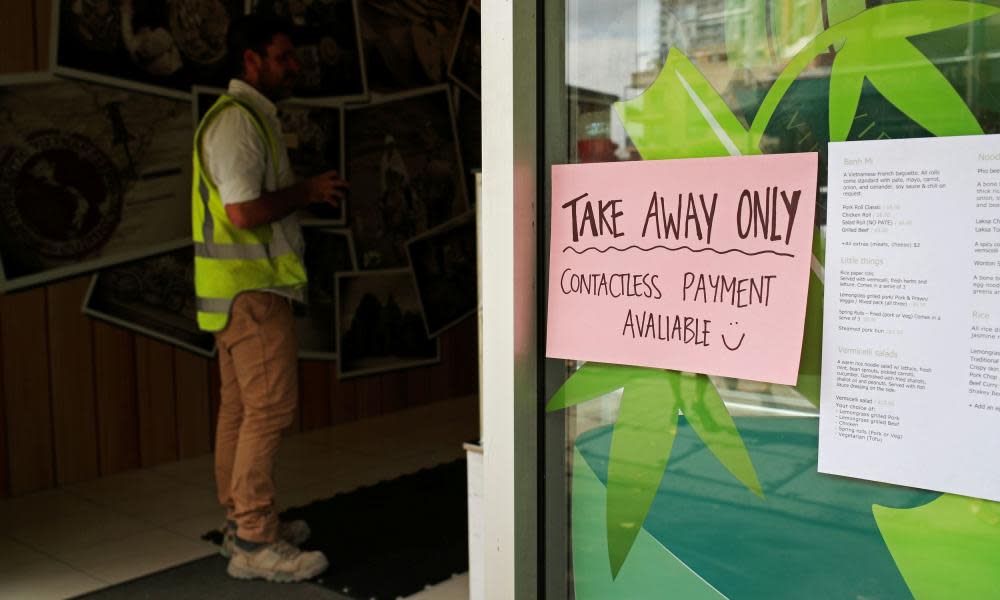Am I eligible for the JobKeeper payment? Here's everything you need to know to register

The Morrison government has announced a $130bn support package with a new JobKeeper payment – a wage subsidy to keep Australians in work.
So who exactly is eligible for this payment and how much will they receive?
How much is the payment worth?
The federal government will pay eligible employers $1,500 per fortnight for each eligible worker, about 70% of the national median wage.
JobKeeper is about $400 a fortnight more than the $1,100 JobSeeker payment with the coronavirus supplement for those out of work.
Who is eligible for JobKeeper?
In order to receive a payment, both the employer and employee must meet eligibility criteria.
Eligible employers are businesses (including companies, partnerships, trusts and sole traders), not-for-profits and charities:
With a turnover of less than $1bn that have lost 30% or more of their revenue compared to a comparable period a year ago.
With a turnover of $1bn or more and with at least a 50% reduction in revenue compared to a comparable period a year ago.
The big banks subject to the banking levy are not eligible.
Eligible employees:
Related: Am I eligible for Centrelink payments? How to apply for the coronavirus supplement
Were employed by an eligible employer at 1 March 2020
Can be sole traders, full-time, part-time, or long-term casuals employed on a regular basis for longer than 12 months as at 1 March 2020.
Are at least 16 years of age.
Are an Australian citizen, the holder of a permanent visa, a protected special category visa, a non-protected special category visa who has been residing continually in Australia for 10 years or more, or a New Zealander on a special category (subclass 444) visa.
The government estimates that six million workers will receive this payment. Gig economy workers will be covered, as they are sole traders.
What if I am on a temporary visa?
Scott Morrison explained that New Zealanders on 444 visas will get the payment because “they are part of an ongoing economy in Australia”.
“We are about keeping them part of it economy because they are part of what happens on the other side,” he told reporters in Canberra.
Asked if there would be other exceptions – such as for Pacific workers on temporary visas – Morrison said that some others “are under consideration but for now the short answer to that is no”. So eligibility may be expanded to others, but at the moment many temporary visa holders will be ineligible.
How will it be paid?
Eligible employers will be paid $1,500 per fortnight per eligible employee from 30 March 2020, for a maximum of six months.
Eligible employees will receive from their employers a minimum of $1,500 per fortnight, before tax. Employers are able to top up the payment.
Employers will pay employees as usual and payments will be made to the employer monthly in arrears by the Australian Tax Office.
Will I receive $1,500 even if I ordinarily earn less?
If an employee ordinarily receives less than $1,500 in income per fortnight before tax, their employer must pay them, at a minimum, $1,500 per fortnight, before tax. It is therefore possible for a long-term casual or part-time worker to receive more than their ordinary pay.
What if I was stood down or sacked?
If an employee has been stood down, their employer must pay their employee, at a minimum, $1,500 per fortnight, before tax.
This means that employees of businesses that shut down due to various restrictions – such as cafes, restaurants, theatres, casino workers and the like – will continue to be paid even if they are not working.
If an employee was employed on 1 March 2020, subsequently ceased employment with their employer, and then has been re-engaged by the same eligible employer, the employee will also receive, at a minimum, $1,500 per fortnight, before tax.
Treasurer Josh Frydenberg said this payment “changes the equation” and he expects employers who were forced to lay off workers may now “put them back on the books”.
When will it start being paid?
The subsidy will start on 30 March, with the first payments to be received by employers in the first week of May. In the meantime, employers must continue paying their employees and then claim the money from the first week of May.
Related: Queues at Centrelink offices and MyGov website crashes ahead of coronavirus shutdowns
Businesses will be able to register their interest in participating in the payment from 30 March on the ATO website. At 5pm on Monday 8,000 had already registered.
What about superannuation?
Employers must continue to pay the superannuation guarantee on regular wages but it is up to employer whether they pay superannuation on additional job keeper payments.
For example, a worker who ordinarily receives $1,000 a fortnight plus superannuation will receive the $1,500 JobKeeper payment, with superannuation paid on the first $1,000 and the employer able to decide whether to pay it on the last $500.
Can I get the JobKeeper and other payments?
A person receiving the JobKeeper payment cannot also receive the JobSeeker payment (formerly Newstart). People who have already applied for JobSeeker can withdraw and shift to job keeper payments if they are re-engaged by their employer.
A person cannot be in receipt of JobKeeper payments from two or more employers.
What about eligibility for JobSeeker payments?
Eligibility has been expanded. At the moment, Australians out of work are not eligible for the JobSeeker payment if their partner earns $48,000 or more.
Under changes made on Monday, people will be eligible for job-seeker payments unless their partner earns $79,762 or more.
Does this require legislation?
Yes. Morrison said parliament will reconvene “as quickly as possible” with a smaller than usual sitting in Canberra, as occurred for the last stimulus package.

 Yahoo News
Yahoo News 
